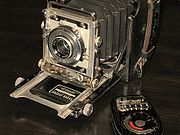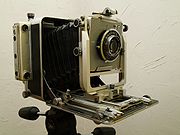
Press camera
Encyclopedia

Camera
A camera is a device that records and stores images. These images may be still photographs or moving images such as videos or movies. The term camera comes from the camera obscura , an early mechanism for projecting images...
suitable for use by press photographers.
Press cameras were widely used from the 1900s through the early 1960s and commonly had the following features:
- collapsibility into strong, compact boxes
- easily interchangeable lensPhotographic lensA camera lens is an optical lens or assembly of lenses used in conjunction with a camera body and mechanism to make images of objects either on photographic film or on other media capable of storing an image chemically or electronically.While in principle a simple convex lens will suffice, in...
es - ability to accept sheet film, film packs, and rollfilm, through the use of interchangeable film backs and holdersFilm holderA film holder is a device which holds one or more pieces of photographic film, for insertion into a camera or optical scanning device such as a dedicated film scanner or a flatbed scanner with film scanning capabilities...
, often conforming to the "Graflock" standard set by GraflexGraflexGraflex was a manufacturer, a brand name and several models of cameras. William F. Folmer, an inventor, built the first Graflex camera in 1898, when his company was called The Folmer and Schwing Manufacturing Company, founded originally in New York as a gas lamp company... - bellowsBellows (photography)In photography, a bellows is the pleated expandable part of a camera, usually a large or medium format camera, to allow the lens to be moved with respect to the focal plane for focusing....
focusing - optical rangefinder focusing
- ground glassGround glassGround glass is glass whose surface has been ground to produce a flat but rough finish.Ground glass surfaces have many applications, ranging from mere ornamentation on windows and table glassware to scientific uses in optics and laboratory glassware....
focusing - handheld operation
- flashFlash (photography)A flash is a device used in photography producing a flash of artificial light at a color temperature of about 5500 K to help illuminate a scene. A major purpose of a flash is to illuminate a dark scene. Other uses are capturing quickly moving objects or changing the quality of light...
-synchronized central shutterShutter (photography)In photography, a shutter is a device that allows light to pass for a determined period of time, for the purpose of exposing photographic film or a light-sensitive electronic sensor to light to capture a permanent image of a scene...
(many older cameras had focal-plane shutters) - reduced number or absence of movements, in contrast to field cameraField cameraA field camera is a view camera that can be folded in a compact size. Modern designs are little different from the first folding field cameras from the 19th century. In general they have more limited camera movements than the monorail cameras used in many professional studios worldwide.Modern field...
s
Some have both a focal-plane and a central shutter, allowing fast shutter speeds and the use of barrel lenses with the focal plane shutter and flash synchronization at any speed with the central shutter.
Press cameras most commonly employ the 4×5 inch film format
Film format
A film format is a technical definition of a set of standard characteristics regarding image capture on photographic film, for either stills or movies. It can also apply to projected film, either slides or movies. The primary characteristic of a film format is its size and shape.In the case of...
. Models have also been produced for the 2.25×3.25 inch format (6×9 cm), and various 120 film
120 film
120 is a film format for still photography introduced by Kodak for their Brownie No. 2 in 1901. It was originally intended for amateur photography but was later superseded in this role by 135 film...
formats from 6×6 cm. through 6×12 cm. European press cameras, such as the Goertz and Van Neck, used the 9x12cm format, marginally smaller than the 4"×5" format.

Photojournalism
Photojournalism is a particular form of journalism that creates images in order to tell a news story. It is now usually understood to refer only to still images, but in some cases the term also refers to video used in broadcast journalism...
and among fine art photographers who use it as a low cost more compact alternative to a view camera
View camera
The view camera is a type of camera first developed in the era of the Daguerreotype and still in use today, though with many refinements. It comprises a flexible bellows which forms a light-tight seal between two adjustable standards, one of which holds a lens, and the other a viewfinder or a...
. Advances in film technology, notably finer film grain
Film grain
Film grain or granularity is the random optical texture of processed photographic film due to the presence of small particles of a metallic silver, or dye clouds, developed from silver halide that have received enough photons. While film grain is a function of such particles it is not the same...
, have obviated the need for large-format cameras for most press assignments, however. In news photography, the press camera has been largely supplanted by the smaller formats of 120 film
120 film
120 is a film format for still photography introduced by Kodak for their Brownie No. 2 in 1901. It was originally intended for amateur photography but was later superseded in this role by 135 film...
and 135 film
135 film
The term 135 was introduced by Kodak in 1934 as a designation for cartridge film wide, specifically for still photography. It quickly grew in popularity, surpassing 120 film by the late 1960s to become the most popular photographic film format...
, and more recently by digital camera
Digital camera
A digital camera is a camera that takes video or still photographs, or both, digitally by recording images via an electronic image sensor. It is the main device used in the field of digital photography...
s.
Press cameras were largely superseded by the 6x6cm medium format Rolleiflex in the early to mid-1960s and later by 35mm rangefinder
Rangefinder camera
A rangefinder camera is a camera fitted with a rangefinder: a range-finding focusing mechanism allowing the photographer to measure the subject distance and take photographs that are in sharp focus...
or single-lens reflex camera
Single-lens reflex camera
A single-lens reflex camera is a camera that typically uses a semi-automatic moving mirror system that permits the photographer to see exactly what will be captured by the film or digital imaging system, as opposed to pre-SLR cameras where the view through the viewfinder could be significantly...
s. The smaller formats gained acceptance as film technology advanced and quality of the smaller negatives was deemed acceptable by picture editors. The smaller cameras generally offered lenses with faster maximum apertures and by the nature of their smaller size, were easier to transport and use. The bulk and weight of the camera itself, as well as the size of the film holders (two pictures per film holder), limited the number of exposures photographers could make on an assignment; this was less of an issue with 12 exposures on a roll of 120 film, or 36 exposures on 35mm film.
Compared to technical cameras, press cameras do not have the range of swing/tilt movements of the front standard, and rarely have back movements due to the fact that many were fitted with focal plane shutters.
List of press cameras
- BeselerCharles Beseler CompanyCharles Beseler Company is a Stroudsburg, Pennsylvania industrial company addressing four primary markets: public and corporate steel shelving and furniture, iron shelving and storage, shrink wrap packaging and silver halide photography...
- Beseler 4×5
- Burke & James Press, Burke & James Inc., Chicago, U.S.A.
- B & J Press (4×5)
- Watson (2×3)
- Busch Pressman
- Model C (2×3)
- Model D (4×5)
- Tower Press (2×3, 4×5) = Busch Pressman, labeled Tower (Sears)
- LinhofLinhofLinhof is a German company, founded in Munich in 1887 by Valentin Linhof. The company is well known for making premium rollfilm and large format film cameras...
- Super Technika
- Technika Press, model of both Graflex XL and Mamiya Press
- Press 70
- Linhof Press (4×5) = Technika III with limited movements
- GraflexGraflexGraflex was a manufacturer, a brand name and several models of cameras. William F. Folmer, an inventor, built the first Graflex camera in 1898, when his company was called The Folmer and Schwing Manufacturing Company, founded originally in New York as a gas lamp company...
, the classic American press camera- Speed Graphic (3×4, Pacemaker 4×5)
- Miniature Speed Graphic (2×3)
- Crown Graphic (3×4, 4×5)
- Miniature Crown Graphic (2×3)
- Century Graphic (2×3)
- Super Crown Graphic (4×5)
- Super Speed Graphic (4×5)
- Kalart Press (3×4)
- Omega
- Koni Omega
- Rapid Omega
- MamiyaMamiyais a Japanese company that today manufactures high-end cameras and other related photographic and optical equipment. With headquarters in Tokyo, it has two manufacturing plants and a workforce of over 200 people...
- Mamiya Press
- Mamiya Universal
- Plaubel MakinaPlaubel MakinaThe Plaubel Makina was a series of medium format press cameras. The original Makina was manufactured by Plaubel & Co. in Germany from 1912 through 1953...
- Meridan 45 (A, B, maybe C)
- Press King, B&W Manufacturing Co., Ontario, Canada
- Ramlose Model A (4×5)
- Topcon
- Topcon Horseman
- Toyo Super Graphic (4×5)
- Van Neck, derivative of Goertz press camera
- Thornton-PickardThornton-PickardThornton-Pickard was a famous British camera manufacturer established in 1888. The company was based in Altrincham, near Manchester and was an early pioneer in the development of the camera industry.-Brief history of the company:...
, pre-World War II camera manufacturer in the UK - Micro Precision ProductsMicro Precision ProductsMicro Precision Products Ltd was a British optical company that between 1941 and 1982 produced cameras and related equipment....
- MPP MicroPress—English design focal plane shutter camera from 1950s, based on top rangefinder Speed Graphic
See also
- Field cameraField cameraA field camera is a view camera that can be folded in a compact size. Modern designs are little different from the first folding field cameras from the 19th century. In general they have more limited camera movements than the monorail cameras used in many professional studios worldwide.Modern field...
- WeegeeWeegeeWeegee was the pseudonym of Arthur Fellig , a photographer and photojournalist, known for his stark black and white street photography....
—Reporter-turned-artist. One of the most well-known users of press cameras. - Digital cameraDigital cameraA digital camera is a camera that takes video or still photographs, or both, digitally by recording images via an electronic image sensor. It is the main device used in the field of digital photography...
- Louis MendesLouis MendesLouis Mendes is a photographer from New York City who is known for his signature press camera, portraits and street photography....
The most recognized and well-known user of the press camera alive today.

